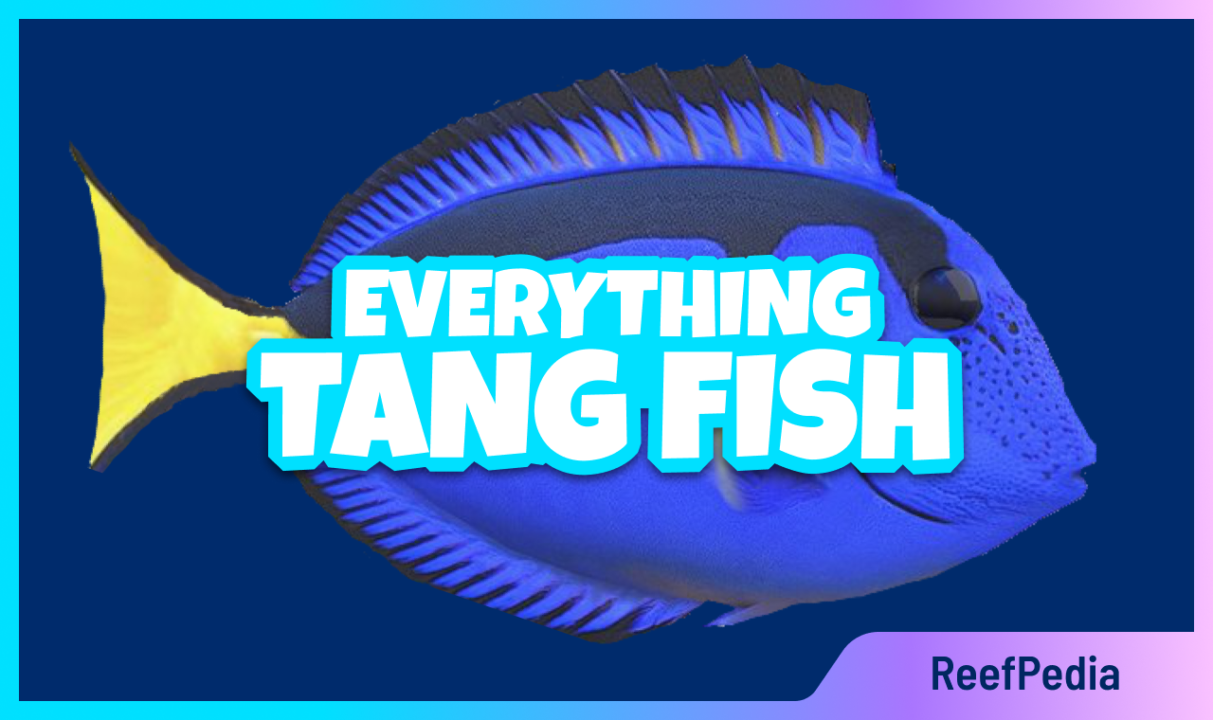Table of Contents
General information about Tangs
Tangs are a common name for a family of bony fish from the suborder Acanthuridae. The tang family includes about 80 species that inhabit only marine waters. These are typical tropical water residents, especially prevalent around coral reefs.
Most species are found in the Pacific Ocean, Indian Ocean, Caribbean region, and some in the Atlantic. They are encountered at depths of up to 100 meters. Tangs are long-lived fish, sometimes reaching up to 30 years of age. Their bright, contrasting colors make them very attractive, and they are commonly seen in marine aquariums worldwide. In the wild, they swim in small groups. In an aquarium, it is recommended to keep individual specimens as they need more space to establish their territory. This family of fish is well-suited to be kept in aquariums alongside corals. They should ideally be maintained in large tanks where algae naturally grow, which tangs will eagerly graze on. The ideal tank for tangs is around 800 liters.
Tangs – distinctive characteristics
All types of tangs have a long dorsal fin and a narrow body, with very fine scales, small mouths, and small teeth. These teeth allow them to scrape coral reefs for tiny organisms. Additionally, they possess sharp, scalpel-like spines at the base of the tail fin, used for defense or intimidation. Moreover, tangs are constantly searching for food, such as algae growing on the substrate. They also feed on benthic algae, zooplankton, frozen foods, algae-based dry foods, and various other types of nourishment.
The most popular Tangs in marine aquariums
Below are some examples of the most popular fish from the tang family, commonly kept in marine aquariums.
Paracanthurus hepatus
Paracanthurus hepatus is one of the most well-known species of marine fish from the tang family. Its distinctive coloration includes a blue body with a black dorsal area and yellow fins. It is notable for the sharp spines located on its tail, one on each side, used for defense. In its natural habitat, it often lives in pairs or forms small groups of 8 to 14 individuals. The maximum body length of this tang can reach 31 cm, though it generally grows to about 20 cm, requiring a relatively spacious tank. This species thrives best in a temperature range of 24 to 26°C and a salinity of 1.021 to 1.024. Additionally, it appreciates hiding spots in the aquarium, where it can retreat if something frightens it. At night, its blue color fades, likely helping it avoid nocturnal predators.
While not the most challenging fish to maintain, it is worth noting that Paracanthurus hepatus is skittish. Excessive stress can make it susceptible to diseases such as marine ich. Introducing this species to an aquarium should occur only once the tank is fully stable. Therefore, beginner aquarists must be patient, as achieving stable water conditions takes time.
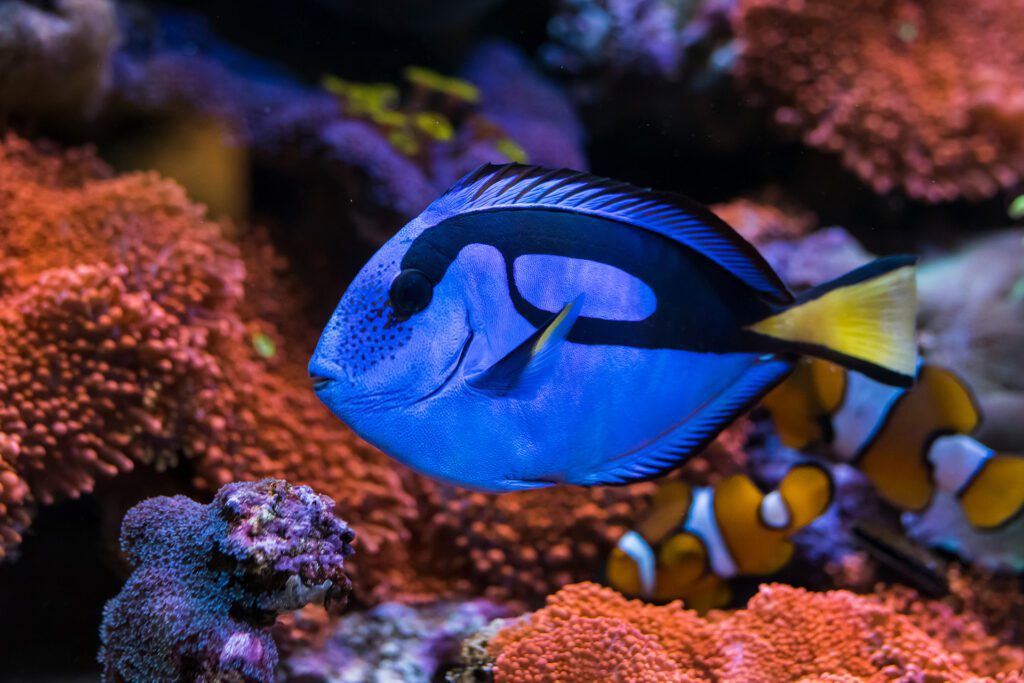
Zebrasoma flavescens
Zebrasoma flavescens is one of the most popular tangs found in marine aquariums. This fish has a vibrant, lemon-yellow coloration across its entire body. The dorsal and anal fins are rounded and quite tall, giving the fish an elongated shape. Very social, it can sometimes show mild aggression. However, once properly acclimated, it is highly resilient and makes an excellent attraction in marine aquariums. A small specimen requires at least a 300-liter aquarium with ample swimming space. It thrives best at temperatures between 24–28°C and a salinity of 1.021–1.024. Like other tangs, its diet mainly consists of plant-based foods, particularly algae. Due to its hardiness, this species is suitable for beginner aquarists.
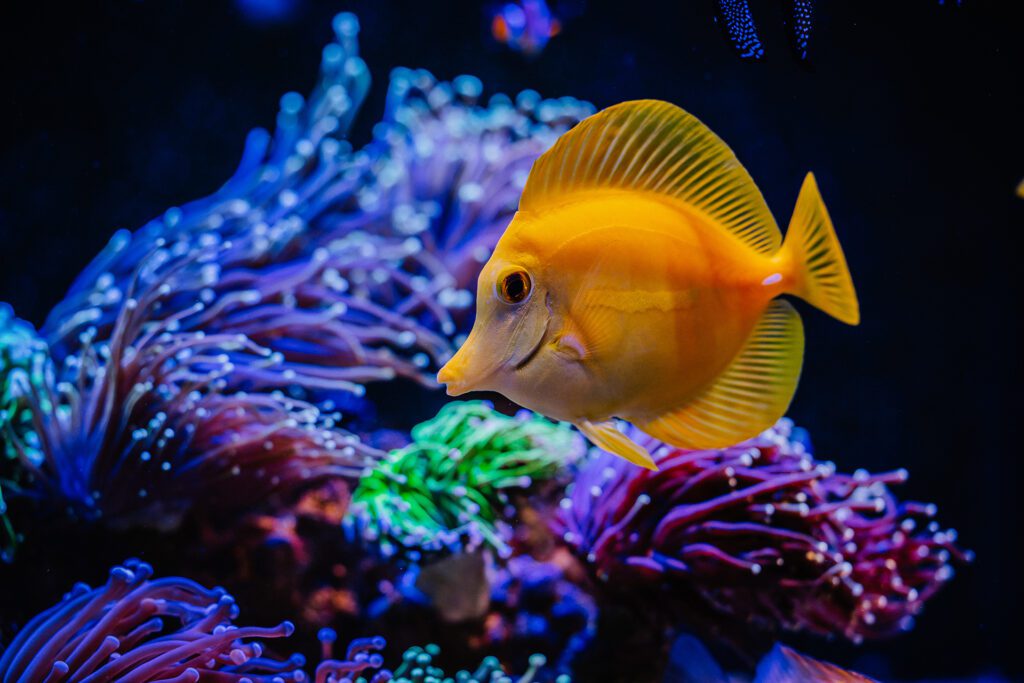
Naso elegans
Naso elegans is another species of saltwater fish from the tang family. This beautiful fish is distinguished by its contrasting coloration, featuring a dark head with a broad yellow stripe above the eyes, yellow dorsal fins, a dark brown anal fin, and a yellowish tail fin with a black border. At the base of the tail, there are two orange spots. Like other tangs, it primarily feeds on algae, favoring plant-based foods. It is aggressive toward other members of its family but peaceful with other reef inhabitants. A small specimen requires at least a 500-liter aquarium with plenty of swimming space. Due to its somewhat territorial nature, only one individual should be kept per tank. It thrives best at temperatures of 24–28°C and a salinity between 1.021–1.024.
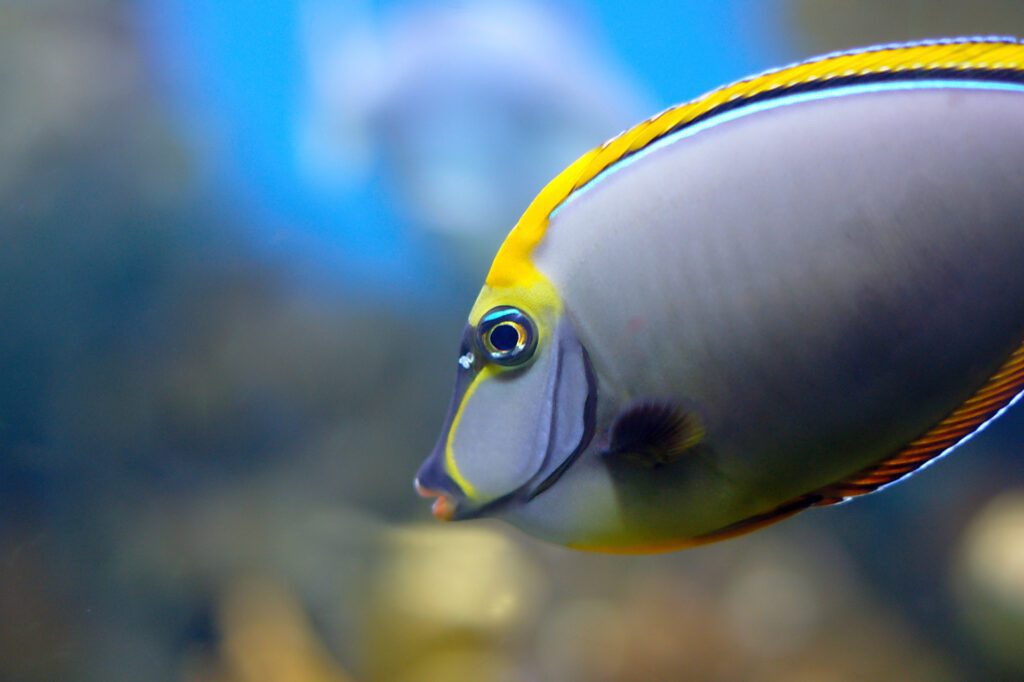
Acanthurus leucosternon
Acanthurus leucosternon, also known as the blue tang, is very popular among aquarists. It is distinguished by its beautiful light blue body with a yellowish dorsal fin. Like other tangs, Acanthurus leucosternon has a sharp spine on both sides of its tail base. Similar to other species in the tang family, it feeds on algae and requires ample swimming space. This species can grow quite large, reaching up to 50 cm in the wild, though it generally does not exceed 30 cm in aquariums. Preferring water temperatures between 24–26°C, it is also sensitive to water quality.
When choosing to keep Acanthurus leucosternon, it is essential to carefully select tank mates, as even in large aquariums, this fish often becomes the dominant individual. Ideally, this tang should be introduced as the last fish in the aquarium. Its sensitivity to water quality and fluctuations makes it unsuitable for beginners. Acanthurus leucosternon should be kept only by experienced aquarists. If it contracts marine ich, treatment is challenging, and the disease can quickly spread to other fish in the tank.
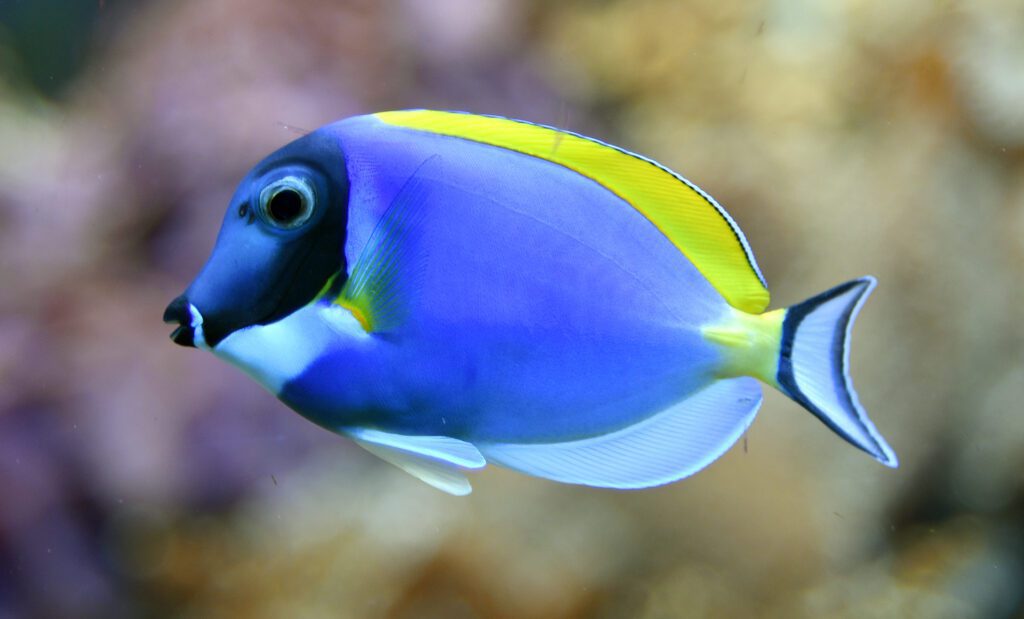
Zebrasoma xanthurum
Zebrasoma xanthurum is another stunning representative of the popular tang family. It is characterized by contrasting colors – a vibrant purple body with an intensely yellow tail and yellow-edged pectoral fins. In the wild, it inhabits areas like the Indian Ocean, Red Sea, Maldives, Israel, Yemen, Oman, Somalia, Egypt, and the Persian Gulf. It grows to an average body length of about 22 cm and requires at least an 800-liter aquarium with ample swimming space. While it is possible to keep it in a 600-liter aquarium initially, an adult will eventually need a larger tank. Like other tangs, Zebrasoma xanthurum should be fed plant-based foods, especially algae. This fish also consumes pressed seaweed, mysis shrimp, and brine shrimp. Regular feeding and a substantial amount of food are essential for its well-being. Water parameters should remain stable, with a recommended temperature range of 23°C to 27°C. Although moderately aggressive toward other inhabitants, it needs a large swimming area.
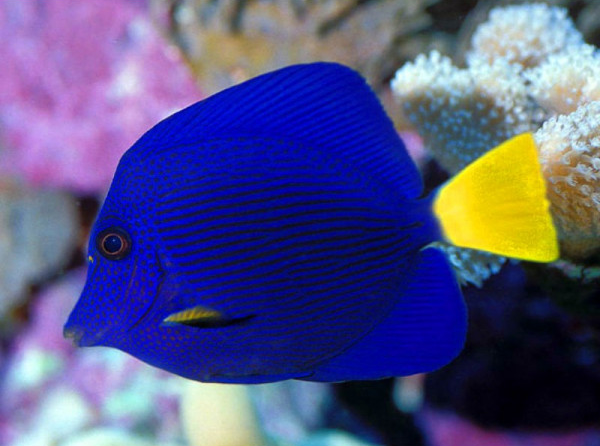
Zebrasoma scopas
Zebrasoma scopas is a large tang, reaching up to 40 cm in the wild. Its body structure is similar to that of Zebrasoma flavescens, and its coloration shimmers in shades of brown, yellow, and gray. In aquariums, it typically does not exceed 25 cm. This species is widespread throughout the Indo-Pacific region. It is easy to maintain and acclimates quickly. As with other tangs, it is recommended to keep Zebrasoma scopas in a large aquarium of at least 600 liters, with plenty of swimming space. It feeds on plant-based foods and eagerly consumes unwanted algae growing on rocks. Specimens kept in smaller tanks may become aggressive. Scopas tang thrives best in water temperatures ranging from 24°C to 28°C.
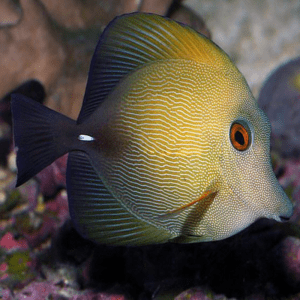
Zebrasoma valiferum
Zebrasoma veliferum is a beautiful fish with intricate body patterns. A distinctive feature is its tall, wide, striped dorsal and anal fins. Young specimens display yellow and black stripes on their bodies. Zebrasoma veliferum is found in the Pacific and Indian Oceans. They should be kept in a minimum 600-liter aquarium with ample swimming space, though as the fish grows, it will need to be moved to a larger tank. These fish can reach up to 40 cm, making them one of the larger species in the Zebrasoma genus. Zebrasoma’s diet includes brine shrimp and algae. Among tangs, this is one of the more peaceful species, making it an excellent and unobtrusive companion for other aquarium residents. In addition to ample swimming space, this species requires a significant amount of rock arranged to create numerous hiding spots.
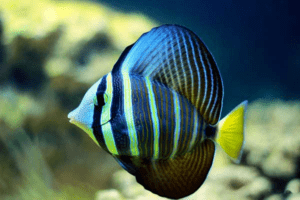
Acanthurus achilles
Acanthurus achilles is considered one of the most beautiful marine fish species. It is found in the Central and Eastern Pacific, including the Oceanian Islands, Hawaii, and the coast of Mexico. The fish’s body is typically dark brown, dark gray, or matte black. At the base of the tail fin, there is an orange or dark yellow teardrop-shaped spot (which can even appear red in some varieties). This area also features a sharp, retractable spine. Acanthurus achilles is very aggressive toward other tangs and often toward other larger fish, such as triggerfish. This fish has a warrior-like nature and loves to swim energetically. Keeping only one individual of this species is recommended. A large tank, ideally 800 liters, is required to accommodate its needs. The recommended water temperature is 24°C to 28°C. In the wild, it primarily feeds on algae growing on rocks. Additionally, it eagerly consumes plant-based foods like pressed seaweed, mysis shrimp, and brine shrimp.

Acanthurus sohal
Acanthurus sohal is a large tang with highly attractive coloration. This species is prone to diseases, so it should be primarily fed vitamin-rich plant-based foods, especially those containing beta-carotene, which may help prevent disease development. Additionally, supplementing its diet with seaweed and algae-based foods is essential. This helps strengthen its immune system, reduces aggression, and improves its overall health. The sohal tang is an aggressive fish and requires a large tank with ample swimming space. Due to its aggression level and size, it should only be kept by an experienced aquarist in a spacious aquarium. The recommended water temperature is 22–26°C.
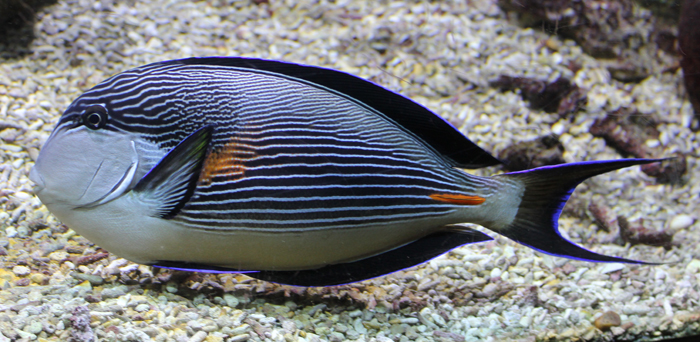
Tangs and their aggression in the aquarium
Tangs are not easy fish to maintain. Most of them, once acclimated, pose no threat and can coexist well with other fish. However, it’s important to know which species to introduce first. In smaller aquariums, it is best to keep single species of larger tangs. It is essential to place them in a large tank with ample food supply. Additionally, it is crucial that they differ in size to easily establish a hierarchy. Large fish, such as Naso elegans, tend to be beyond any species-specific hierarchy, and therefore, it is rare for another tang to attempt an attack. Dominant species include Acanthurus leucosternon and Acanthurus sohal.
Tangs and their role in a marine aquarium
Tangs play an important role in the marine environment by cleaning corals of overgrowing algae. Additionally, their vibrant colors and dynamic behavior make them an attractive addition to any marine aquarium. This is a family of territorial fish, often aggressive toward others of their species. It is recommended to add them as one of the last fish in the tank. Space is a priority for them, allowing for free movement and the establishment of individual territories. The ideal temperature range is 24°C to 26°C. Intensive lighting and proper filtration are also essential. Furthermore, using LED lighting enhances the natural colors of these beautiful fish.
Summary
Tangs are beautiful fish, highly desired by marine aquarists. If we decide to purchase them, it’s essential to thoroughly research their requirements and aggressive tendencies. They should not be bought without carefully checking all relevant information. On the other hand, it’s hard to imagine a marine aquarium without a stunning tang.
About the author

Marek Protasewicz
Reefkeeping has been my passion for over 10 years now. I love learning. The hobby has taught me many valuable lessons, patience being the best example. Combining work and passion is my path. I run Crazy Coral, a marine aquarium shop, for a number of years. Building this business from the scratch I learnt from my own mistakes at a heavy cost.
Later I managed a project aimed at development of methods for quick growth of Corals in non-natural conditions. The project was carried out by Get Sales, Poland. Presently, I am responsible for distribution strategy at Reef Factory, of which I am a co-founder. The company produces smart devices for marine aquaristics. The last projects I have been involved in are Social Reef and ReefPedia.

